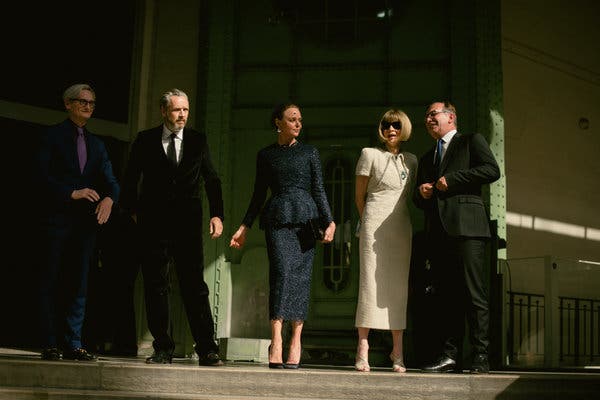PARIS — Like many complex and forceful people Karl Lagerfeld — the German-born and Paris-based designer who, until his death in February, had been creative director of Chanel since 1983 and Fendi since 1965 — was one person to the wide world and another to his friends.
Concealed behind the armor Mr. Lagerfeld wore in public — dark glasses, tight black jeans, ponytail whitened with imported Japanese powder, fingers barnacled with Chrome Hearts rings — was a man who in reality spent many of his adult years living with his mother and later (and more publicly, until his death at 85) with his Birman cat, the feline Instagram star Choupette.
“Karl liked the recognition,” Amanda Harlech, a British aristocrat who was the designer’s creative helpmate for decades, said on Thursday before a memorial sponsored by Chanel, Fendi and Karl Lagerfeld, the brand. More than 2,500 invited guests assembled on a gusty summer evening inside the monumental cast-iron and glass cathedral that is the Grand Palais, natural light still filtering in well into the night on the cusp of the solstice. “Karl would say, ‘The whole world recognizes me, but they don’t know me at all’,” Ms. Harlech said.

CreditDmitry Kostyukov for The New York Times
A layered personality who claimed to have “a Google brain” and to ignore the past was evoked during a tapestried tribute featuring video testimonials and clips from throughout his long life and readings from favorite authors like Stéphane Mallarmé, Colette and Edith Sitwell performed by Tilda Swinton, Fanny Ardant and Helen Mirren. There also were performances by Lil Buck, the star of a Memphis dance style called jookin; Pharrell Williams; the concert pianist Lang Lang, who played Chopin; the violinist Charlie Siem; and a troupe of 17 tango dancers from Argentina. “Karl loved music and he loved to dance,” Ms. Harlech said. Among his favorite entertainments, she added, was driving late at night along the corniche in St.-Tropez with the top down on his convertible Rolls-Royce. “He’d stand on the seat with ‘Bohemian Rhapsody’ playing full blast,” she said.
A polyglot designer, photographer, director, publisher and proprietor of a Left Bank bookshop that fueled his bibliophile addiction, Mr. Lagerfeld hurtled through life collecting furniture, houses, experiences and people and operating according to one simple precept: Never look back.
“He saw sensitivity as weakness,” Victoire de Castellane, creative director of Dior Jewelry, said.
Mr. Lagerfeld himself once expressed similar sentiments, although more flatly. “When people show me their behinds, it doesn’t bother me,” he said, using a saltier term. “When they show me their feelings, I don’t like it at all.”
Like Andy Warhol, Mr. Lagerfeld was endowed with formidable gifts, possessed of seemingly boundless energy and a steely ego. He also, like Warhol, had a distaste for his own physical form. “Karl physically hid himself — behind his work, behind his desk, behind his fan, behind his mountains of books,” said Francesca Amfitheatrof, a longtime Lagerfeld collaborator and now artistic director of the jewelry division at Louis Vuitton.
For many years, Ms. Amfitheatrof noted, Mr. Lagerfeld struggled with his weight before rigorous dieting delivered his slender body ideal. “He even hid his hands with rings,” Ms. Amfitheatrof said, adding that Mr. Lagerfeld’s mother, an accomplished violinist, famously discouraged him from following in her musical footsteps, in part because she claimed he had ugly hands.
Known as Kaiser Karl to outsiders, Mr. Lagerfeld was extravagant with those in his circle, sentimental and supportive, demanding loyalty but also returning it, friends said. “He had a family, and everybody in it had their place and their part,” said Michel Gaubert, a sound designer who for three decades created the soundtracks for Mr. Lagerfeld’s opulent Chanel shows, for which the designer plundered the corporate coffers to transform the Grand Palais into a supermarket, a cruise ship or a beach. Once, on a whim, Mr. Lagerfeld had an iceberg trucked in from Sweden to use as a backdrop for a ready-to-wear collection.
“It was a little like a court,” Mr. Gaubert added. “The king is hungry, the king wants to party, the king wants to dance.”


For some in a gathering that included Anna Wintour, the editor of American Vogue and artistic director of Condé Nast; the Japanese artist Takashi Murakami; platoons of Chanel-clad members of the French elite; and Bernard Arnault, billionaire owner of LVMH Moët Hennessy Louis Vuitton, Mr. Lagerfeld was remembered less for his contributions to fashion across a half century at the top of the industry than for his omnivorous appetite for each new turning in the culture, a compulsion to learn about the next big literary, photographic, artistic or intellectual thing.
Speaking in rapid-fire pronouncements in the three languages in which he was fluent (German, French and English), Mr. Lagerfeld charged through life without stopping except, perhaps, to compose the personal notes for which he was famous among friends or to express a playfulness and sentimentality that the public seldom saw.
“Karl is faithful, very faithful” to friends, said Carine Roitfeld, the former editor of French Vogue, who was appointed style adviser to the Karl Lagerfeld label soon after his death. “I still talk about him in the present,” Ms. Roitfeld added, “because for me he’s still here.”







